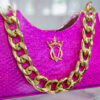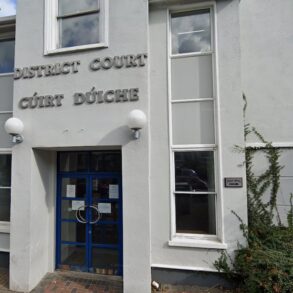Counterfeit handbags have existed for decades, but the latest generation of so-called “superfakes” can so closely resemble their luxury counterparts that the differences are almost imperceptible to the human eye.
You might be carrying a Hermès Kelly bag worth $100,000. Or it could be a hyper-realistic rip-off worth a fraction of the price.
Either way, only you are likely to know the truth about your handbag’s origins.
The superfake revolution has sparked a debate about the ethics of counterfeit goods, as well as raising questions about what exactly we’re paying for when we spend thousands on a scrap of leather.
But in South-East Asia’s largest marketplace, their booming popularity has had some unintended consequences for fashionistas and authorities alike.
Meanwhile, amid a debate about the luxurious lifestyles of Indonesian political figures, some public servants have started insisting their bags are just really good fakes procured from a giant market in Jakarta.
“People here call those superfake bags 1-to-1 replicas,” said Uci Flowdea, a businesswoman who collects real Hermès handbags.
“They’re so close, the untrained eye won’t know,” she said.
Superfake doesn’t mean super cheap
Superfakes are often handmade, use more expensive materials and are difficult to tell apart from the pricey originals.
And at Jakarta’s Mangga Dua market, dubbed “Hong Kong Alley” by some locals, the top superfakes bags come with real luxury prices.
Copies of the luxury industry’s most sought-after handbags from French fashion house Hermès start above $1,000 and stretch up to $10,000 for a replica of a Kelly crocodile-skin bag.
The superfakes might be a serious investment, but they still cost 10 per cent of their genuine counterpart.
A crocodile skin Kelly — the most coveted and rarest of all Kelly bags — can easily cost $100,000.
And that’s only if you’re invited by the brand to make the purchase.
A seller at the Mangga Dua market told the ABC the bags are sourced from factories in southern China, and customers can make requests for particular styles.
The seller, who didn’t want to give his name, said he’d sold six of the top priced replicas already, and he believed they are indistinguishable from the real ones.
The market features on the United States government’s list of “notorious markets” for counterfeit products.
While it was busy when the ABC visited, most of the business takes place online.
The rise of the superfake means that in Australia and abroad, businesses have emerged to help buyers try to verify that their bag purchases aren’t replicas.
The quality of the replicas has improved so much that some Indonesian sellers have tried to pass them off as the real thing, charging wealthy clients tens of thousands of dollars per bag in the process.
How a fake bag dispute escalated into a bomb threat
One buyer who wasn’t fooled by superfakes is Ms Flowdea.
The Surabaya-based businesswoman said she began collecting Hermès bags after tiring of investing her wealth in property and sports cars.
One study in 2016 found that Hermès bags can be a safer investment than gold or the stockmarket.
Ms Flowdea has more than 200 real Hermès handbags, which she has collected by gradually building relationships with boutiques in cities around the world.
But COVID-inducted travel restrictions prompted her to try buying from a local seller in Indonesia.
Last year she ordered four Hermès bags from a well-known influencer for a total of $130,000, only to be suspicious when she unwrapped them.
“When I first glanced at them, they looked convincing. But after I touched them, I could sense it,” she said.
“I’ve been collecting bags for 15 years. I have strong feelings about them. I know if things are off.”
Ms Flowdea said the average person would not have been able to spot the clues.
“Even though they are 1-to-1 replicas, some things were still off, and I found them,” she said.
“A little too much of a gap in the stitching, or a different grain on the leather, or the way the handle feels when holding it.”
Her attempts to get the seller to refund the purchases descended into a nasty public dispute that involved tit-for-tat police reports and even bomb threats.
It culminated in the seller, Medina Zein Azhari, being jailed for nine months in Jakarta for making the threat against Ms Flowdea.
She will then serve another two year-sentence for a scam offence in the city of Surabaya.
When high-powered officials start crying fake
While Ms Flowdea and some other influencers seek to flaunt their luxury possessions, others are scrambling to do the opposite.
Over the past few months, several Indonesian officials or their family members have been spotted with luxury goods, sparking an outcry about the wealth of powerful political families.
In March, the wife of a provincial regional secretary was accused of flaunting luxury handbags on Instagram, only for her husband to claim they were counterfeit and purchased at “Hong Kong Alley”.
An official working in Jakarta was also under scrutiny for the bag his wife was showing off on social media, prompting the city’s acting governor to declare it a superfake.
A string of similar incidents prompted the President Joko Widodo to ban government officials from flaunting their wealth.
“Indonesia’s average annual income is $6,800 per year, so owning luxury goods presents a significant challenge for most Indonesians,” said economist Andry Satrio Nugroho, of the Institute for Development of Economics and Finance.
“People want to project an image of social status and they’ll resort to counterfeit goods to do it.”
Is the superfake genie out of the bottle?
Despite the growing demand for luxury goods in South-East Asia, the production still largely takes place in China.
“Eighty to 90 per cent of fake goods come from China and Hong Kong,” said Police Brigadier General Anom Wibowo, the Director General of the Anti-Counterfeit Unit for the Indonesian government’s intellectual property body.
While knock-offs can still be found in many markets around China, an annual report from the US Trade Representative office found police raids at physical marketplaces have helped to diminish their importance for the counterfeit business there.
But a boom in direct e-commerce sales to other countries over the past decade has helped fuel a four-fold increase in Chinese customs seizures of goods bound for export due to intellectual property infringements.
Gucci was the most popular brand for counterfeit seizures by Chinese authorities between 2014 and 2021, with fines issued for more than 4 million items, according to Chinese government data compiled by IP consultancy Rouse.
In recent years, Chanel, Louis Vuitton and Christian Dior have also seen an increase in counterfeit seizures, which the Rouse analysts partly attribute to the activity of their anti-counterfeiting teams.
But plenty of fake bags, watches, shoes, belts and other items are still successfully making their way out of China.
In Indonesia, sellers, both online and in markets, peddle fake products with little fear of the authorities shutting them down.
That’s despite maximum penalties of five years in jail and fines of up to $200,000.
“The law calls for the brand owners or license holders appointed by the brands to file a report along with submitting preliminary evidence,” said Anom Wibowo of the government’s anti-counterfeit body.
“So without the brands filing complaints, we don’t have the legal standing to process the case even though we can see the fake goods out there,” he said.
“What we can do when we encounter fake goods is, we can take note and then contact the brand owner — if they don’t like their good being copied then they can come to our office and file a report.”
While he says some overseas brands have been proactive in contacting Indonesian authorities about counterfeit goods, many haven’t.
And he said with the rise of superfakes, it’s increasingly difficult for the anti-counterfeit police to determine what’s real and what’s not.
“We hope to work together with brand owners on these challenges,” he said, noting that his officers also go to markets like Mangga Dua to educate stallholders to sell authentic local products instead of counterfeit goods.
He concedes it’s not a popular message at the market, but is hopeful that a memorandum of understanding to be signed soon with some Indonesian e-commerce giants will help discourage sellers of fake products.
A perception that selling replica luxury items is a victimless crime, given the exorbitant prices of the real bags, also influences views in Indonesia.
“A crime remains a crime,” said Mr Satrio Nugroho.
“The victims here aren’t just luxury brands, it also extends to small and medium businesses, and it undermines intellectual property rights for everybody.”
But with little enforcement by authorities to target the counterfeit bag traders, the business will likely continue to thrive in Indonesia.
For Ms Flowdea though, there’s nothing like the genuine product.
“Many people carry fake Hermès bags because they want one but don’t have enough money,” she said.
“But if we appreciate ourselves, why would we wear a fake thing so close to our body?”






